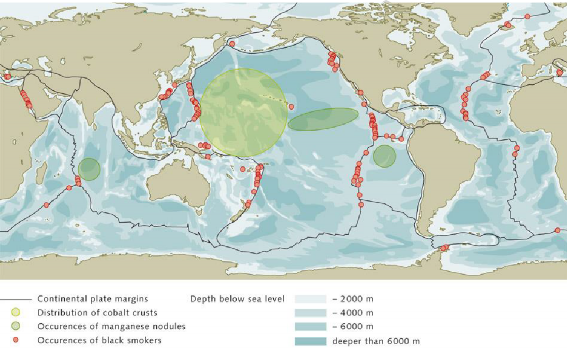3.4.2. Major Deep Sea Minerals
The major focus is on manganese nodules, which are usually located at depths below 4000 metres, gas hydrates (located between 350 and 5000 metres), and cobalt crusts along the flanks of undersea mountain ranges (between 1000 and 3000 metres), as well as massive sulphides and the sulphide muds that form in areas of volcanic activity near the plate boundaries, at depths of 500 to 4000 metres.
Manganese Nodules
Manganese nodules are lumps of minerals covering huge areas of the deep sea with masses of up to 75 kilograms per square metre. Manganese nodules are composed primarily of manganese and iron. The elements of economic interest, including cobalt, copper and nickel, are present in lower concentrations and make up a total of around 3.0 per cent by weight. In addition there are traces of other significant elements such as platinum or tellurium that are important in industry for various high-tech products.
These chemical elements are precipitated from seawater or originate in the pore waters of the underlying sediments. The greatest densities of nodules occur off the west coast of Mexico, in the Peru Basin, and the Indian Ocean.
Cobalt crusts
These crusts accumulate when manganese, iron and a wide array of trace metals dissolved in the water (cobalt, copper, nickel, and platinum) are deposited on the volcanic substrates. The cobalt crusts also contain relatively small amounts of the economically important resources. Extracting cobalt from the ocean is of particular interest because it is found on land in only a few countries (Congo, Zaire, Russia, Australia and China), some of which are politically unstable.
Cobalt crusts form at depths of 1000 to 3000 metres on the flanks of submarine volcanoes, and therefore usually occur in regions with high volcanic activity such as the territorial waters around the island states of the South Pacific.
Massive Sulphides
Sulphur deposits produced from underwater volcanic areas are known as black smokers. These occurrences of massive sulphides form at submarine plate boundaries, where an exchange of heat and elements occurs between rocks in the Earth’s crust and the ocean due to the interaction of volcanic activity with seawater.
Cold seawater penetrates through cracks in the sea floor down to depths of several kilometres. Near heat sources such as magma chambers, the seawater is heated to temperatures exceeding 400 degrees Celsius. Upon warming, the water rises rapidly again and is extruded back into the sea. These hydrothermal solutions transport metals dissolved from the rocks and magma, which are then deposited on the sea floor and accumulate in layers. This is how the massive sulphides and the characteristic chimneys (black smokers) are produced.
So far only a few massive sulphide occurrences which are of economic interest due to their size and composition are known. While the black smokers along the East Pacific Rise and in the central Atlantic produce sulphides comprising predominantly ironrich sulphur compounds – which are not worth considering for deep-sea mining – the occurrences in the southwest Pacific contain greater amounts of copper, zinc and gold. The largest known sulphide occurrence is located in the Red Sea Here, the sulphides are not associated with black smokers, but appear in the form of iron rich ore muds.
Figure 9. Distribution of Deep Sea Minerals

3.4.3. Constraints in Deep Sea mining
Major problems associated with deep sea mining are:
♤ The most limiting factors associated with deep-sea marine mining are the political and legal aspects. Legal and political issues surrounding exploration, exploitation, and marketing of sea floor minerals must be resolved.
♤ The excavation of marine minerals would considerably disturb parts of the seabed. Huge amounts of sediment, water, and countless organisms would be dug up with the nodules, and the destruction of the deep-sea habitat would be substantial. It is not yet known how, or even whether, repopulation of the excavated areas would occur.
♤ Sea floor mining will only be able to compete with the substantial deposits presently available on land if there is sufficient demand and metal prices are correspondingly high.
♤ The excavation technology has yet to be developed. There are serious technological difficulties in separating the crusts from the substrate which combined with the problems presented by the uneven sea floor surface further reduce the economic potential of the marine mining.
Despite the challenges, deep sea mining has some potential benefits over terrestrial mining:
♤ The minerals are often much closer to the surface, so operations have to dig and displace less rock, meaning a smaller footprint and fewer carbon emissions.
♤ Seabed mining infrastructure is both moveable and reusable, unlike roads and buildings often left behind at abandoned mines on land.
♤ And no residents will be directly displaced by mining.
